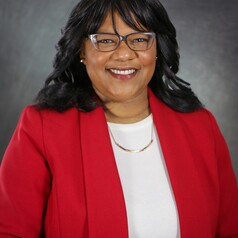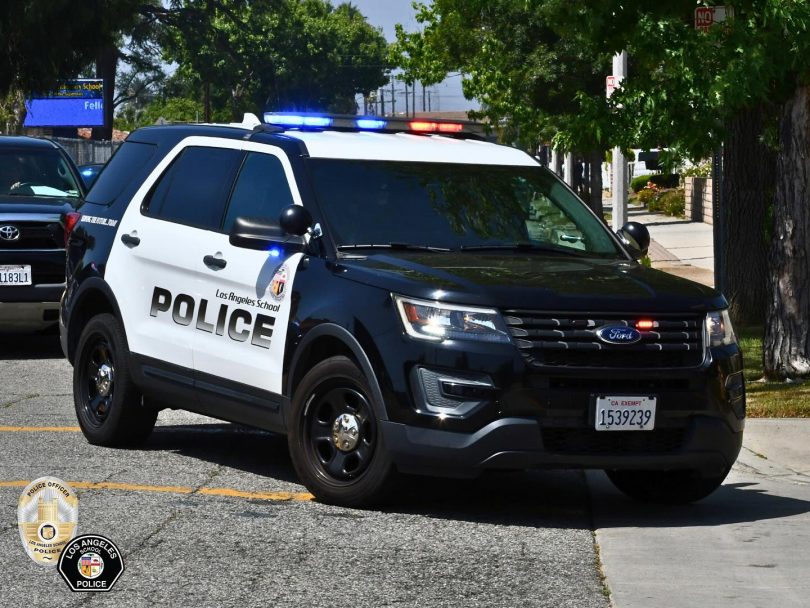Editor’s Note: An update on LAUSD and school police in LA County
The Los Angeles Unified School District has long had its own police department, which, like other law enforcement agencies, has faced community pushback over their trend of disproportionately arresting Black people — in this case, Black kids and teens.
In, 2018, a study by UCLA’s Million Dollar Hoods Project found that black kids made up 24 percent of the Los Angeles School Police’s total arrests, citations, and diversions. This is despite black students representing less than nine percent of the district’s student population.
In June 2020, the LAUSD board voted to cut $25 million from the $70 million budget for the nation’s largest school police department. The board also elected to remove officers from the district’s more than 1,000 schools. This meant that, instead of being stationed on campus, LASP officers were directed to patrol the neighborhoods around the schools.
The move came in response to calls from dozens of community groups to cut funding from law enforcement and to eliminate the ways kids are pushed out of the classroom and into the criminal legal system.
The budget cut led to the elimination of one-third of the LASP’s force — a total reduction of 133 positions, including 70 gun-carrying sworn officers, and 62 non-sworn “School Safety Officers.”
The $25 million cut from the LASPD budget, plus an additional $11.5 million from the LAUSD’s general fund, was earmarked for implementing a Black Student Achievement Plan (BSAP), which included hiring “school climate coaches,” and other counselors and support staff. Funding for the BSAP was later increased to more than $100 million.
The goal has been to ensure school instruction and materials are culturally responsive to Black students, to close gaps in literacy and math skills, and to reduce racial disparities in school discipline, in part, by better meeting kids’ various needs.
In January 2023, the Police Free LAUSD Coalition issued a 52-page report outlining how kids are criminalized at school, and how the school district can and should replace campus police with more counselors and services for students. Money saved by dismantling the LASP, the report said, could be used to hire nurses, mental health professionals, and restorative justice facilitators, and to ensure that every school has a climate coach.
By, February 2023, only 20% of BSAP funding had been spent, and the district had only distributed $2.5 million out of the $15 million set aside for Community-based Safety Pilot programs. And, students had reported seeing an increase in police presence on campus.
On April 10, 2024, the district announced it would eliminate 50 vacant LASP positions and spend $3.7 million on Safe Passage and restorative justice programs.
Just one month later, in May 2024, LAUSD Superintendent Alberto Carvalho tried to reinstate officers on 20 campuses in response to requests from concerned parents after two students brought loaded semi-automatic handguns to Northridge Middle School, and a student was fatally shot several blocks away from Washington Preparatory High School. The school board ultimately rolled back the superintendent’s decision, keeping campus police temporarily, only at Northridge and Washington Prep.
Yet, as of June 2024, according to the Police Free LAUSD Coalition, the district had “failed to effectively build out a comprehensive system of safe passages, peace-building, violence prevention/intervention, de-escalation, conflict resolution, restorative and transformative justice, and youth development programs to cultivate school safety as demanded by thousands of students, parents, educators, and community.”
And, over the last week, the LASP faced criticism from parents and teachers for its handling of a lockdown at Northridge Middle School on November 14, 2024, during which officers in riot gear “forcefully entered random classrooms, pointing their rifles at students and staff,” according to the United Teachers Los Angeles labor union.
While the circumstances surrounding the alarming lockdown are not entirely clear, ABC7 reported that LASP had been “conducting a search near the campus,” and that the department locked the school down as a precaution.
With all of the above in mind, we thought WitnessLA readers would be interested in the op-ed below, in which Monic Behnken, Associate Dean of the Department of Sociology and Criminal Justice at Iowa State University, explores the common drawbacks associated with having dedicated school police officers.
Why school police officers may not be the most effective way to prevent violence
By Monic Behnken, The Conversation
In 1975, only 1% of public schools had their own police officers. Today, 44% do. A large reason for the increase is the Violent Crime Control and Law Enforcement Act of 1994, which led to the creation of the federal Community Oriented Policing Services to oversee funds for the hiring of police in schools. Another reason is the Columbine High School massacre in 1999. From the federal government down to individual districts, the idea that schools need police officers to keep kids safe is prevalent.
However, research shows that police officers in schools don’t always prevent violence, including school shootings. In fact, their presence can harm students.
Here are five reasons police in schools, also known as school resource officers, actually make students less safe in school:
1. They don’t address the root problems
State legislators who advocate for police in schools believe that by hardening schools – increasing police presence, adding metal detectors, requiring clear backpacks and mandating active-shooter safety drills – students" frameborder="0" allowfullscreen> will be safer from school shootings.
Academic research supports a different strategy. Most school shooters are known to administrators prior to committing assault. Many of these students struggle to make friends, experience challenges in their home lives and have multiple behavioral and mental health needs that haven’t been addressed.
School police officers cannot fix societal problems. Instead, researchers and policy advocates recommend that districts invest in the people who are better equipped to address these issues, like social workers and therapists.
2. Their role is not well defined
The role of school police officers, as well as their training, varies from school to school. This means that some may have a more positive impact on students than others.
Research shows that school resource officers are effective at detecting drug-related activity on campus and addressing violent crime related to gang activity in schools. But officers do not lower instances of bullying and low-level crime like vandalism and schoolyard fights.
School police officers play various roles on campus, but research shows that they are most effective at helping students when they focus on specific types of crime occurring in the school or building relationships with the students who are known to commit them. When they focus on punishment and discipline, their effectiveness decreases.
3. They do not increase students’ feelings of safety
Most students either do not realize that their school has a school resource officer or don’t mind that one is present. In fact, most students report liking the officer at their school.
However, students report that the presence of school resource officers does not make them feel more positive about school safety and climate. Students report feeling safe in the beginning of the year with officers in the building but feel less safe as the year goes on. The more contact students have with an officer, for any reason, the more disconnected they begin to feel. Researchers suggest a possible reason why is because they start to worry that their own behavior can result in harsh punishment.
This can lead to other negative consequences, like increased absenteeism, failure to graduate and delinquency outside of school.
Students who frequently encounter school police officers can begin to develop subconscious feelings that their school is unsafe, particularly if their encounters were related to discipline. Even students who don’t directly interact with the officers, but witness other students get arrested, can begin to feel afraid that they will be arrested for minor disturbances, too.
4. They contribute to the ‘school-to-prison pipeline’
Research shows that the presence of school police officers increases the likelihood that a school will report common forms of student misbehavior, like cafeteria fights and vandalism, to law enforcement agencies – contributing to what is known as the “school-to-prison pipeline” by criminalizing such conduct.
For example, schools that use on-campus police for law enforcement and other duties, like mentoring, are 118% more likely to record property crimes than schools without police. Schools that use officers primarily for student discipline and crime response report 91% more nonserious crimes, property crimes and instances of disorderly conduct to police than similar schools that don’t use school police.
Supporters of school police officers may argue that reporting crimes keeps students safer. However, for some students, the consequences can be devastating and lifelong. For example, in one study, North Carolina middle schools with on-campus police officers recorded 38% fewer violent offenses than schools without police. But they were also more likely to respond to student misconduct with harsher disciplinary practices such as school suspension, transfers to alternative learning environments, expulsions and referrals to police. Studies often find that these exclusionary responses are mostly experienced by Black and Hispanic students.
5. They sometimes infringe on students’ rights
The U.S. Supreme Court ruled in 1969 that students do not “shed their constitutional rights to freedom of speech or expression at the schoolhouse gate.”
However, research is clear about the threats to students’ rights that school police officers can pose. These include invasion of privacy, unlawful searches and seizures and violations of rights of students with disabilities and special education students.
Schools that plan to keep their police officers can follow these guidelines to ensure they are more effective in actually helping students:
- Build strong relationships between school administrators and school police officers, which can increase the success of school police programs.
- Clearly outline the roles and duties of school police officers.
- Work as a team with officers and other experts, like social workers and therapists. Simply having a school resource officer isn’t enough to prevent violence.
- Train officers in child development and de-escalation.
- Integrate officers into school and district leadership roles by making them part of the leadership team and providing them with the same professional development as teachers.
As the nation’s schools continue to grapple with how to keep students safe, a careful review of the research shows that school police officers may not be the answer.
This op-ed first appeared in The Conversation.

Monic Behnken, Associate Dean, Department of Sociology and Criminal Justice, Iowa State University

